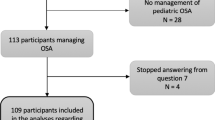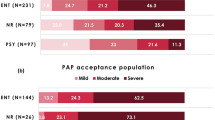Abstract
There is currently no standardized ear, nose, and throat (ENT) clinical examination for patients with sleep-disordered breathing (SDB). As a result, there are large inter-individual differences in the examinations due to an inadequate estimation of the relevance of certain anatomic sites. We aimed to identify which examinations/dynamic tests are considered most relevant by German ENT physicians. A questionnaire was designed, evaluating 23 anatomic sites/dynamic tests of the upper aero-digestive tract. The questionnaire was sent to all German ENT departments (n = 153), including universities and other tertiary or secondary referral centers, by postal mail. In addition, almost all private ENT specialists registered with the German professional association (n = 2496) were contacted via e-mail. Participants assessed how often they examined the sites/dynamic tests, subjective importance, and the impact on the therapeutic procedure. A mean score of relevance (mSOR) was generated (minimum score 1; maximum score 75) from these three items. The response rate for hospitals was 58.8 %; while, it was 4.1 % for ENT specialists in private practice. Therefore, the total response rate was 7.3 %. Of the 23 assessed items, some showed a high overall relevance, such as the tonsils (mSOR 64.75), webbing (mSOR 58.14), uvula (mSOR 55.12), or tongue base (mSOR 53.99). Other examinations, such as simulated snoring (mSOR 19.34) or the Mueller maneuver (mSOR 18.98), were estimated as less relevant. Our data reflect the assessment of German otorhinolaryngologists on the clinical examination of SDB patients. The results should be considered as a basis for compiling a standardized procedure.


Similar content being viewed by others
References
Rombaux P, Bertrand B, Boudewyns A, Deron P, Goffart Y, Hassid S, Leysen J, Liistro G, Marien S, Moerman M, Remacle M (2002) Standard ENT clinical evaluation of the sleep-disordered breathing patient; a consensus report. Acta Otorhinolaryngol Belg 56(2):127–137
Zonato AI, Bittencourt LR, Martinho FL, Junior JF, Gregorio LC, Tufik S (2003) Association of systematic head and neck physical examination with severity of obstructive sleep apnea-hypopnea syndrome. Laryngoscope 113(6):973–980
Acar B, Babademez MA, Karabulut H, Ciftci B, Gunbey E, Karasen RM (2009) Otorhinolaryngologic examination in obstructive sleep apnea syndrome: the correlation between the severity of sleep disorder and physical examination. Kulak Burun Bogaz Ihtis Derg 19(5):246–252
Rodrigues MM, Dibbern RS, Goulart CW (2010) Nasal obstruction and high Mallampati score as risk factors for Obstructive Sleep Apnea. Braz J Otorhinolaryngo 76(5):596–599
Croft CB, Pringle M (1991) Sleep nasendoscopy: a technique of assessment in snoring and obstructive sleep apnoea. Clin Otolaryngol Allied Sci 16(5):504–509
Marais J (1998) The value of sedation nasendoscopy: a comparison between snoring and non-snoring patients. Clin Otolaryngol Allied Sci 23(1):74–76
Quinn SJ, Daly N, Ellis PD (1995) Observation of the mechanism of snoring using sleep nasendoscopy. Clin Otolaryngol Allied Sci 20(4):360–364
Pringle MB, Croft CB (1993) A grading system for patients with obstructive sleep apnoea–based on sleep nasendoscopy. Clin Otolaryngol Allied Sci 18(6):480–484
De Vito A, Carrasco Llatas M, Vanni A, Bosi M, Braghiroli A, Campanini A, de Vries N, Hamans E, Hohenhorst W, Kotecha BT, Maurer J, Montevecchi F, Piccin O, Sorrenti G, Vanderveken OM, Vicini C (2014) European position paper on drug-induced sedation endoscopy (DISE). Sleep Breath Schlaf Atm 18(3):453–465. doi:10.1007/s11325-014-0989-6
Dahlqvist J, Dahlqvist A, Marklund M, Berggren D, Stenlund H, Franklin KA (2007) Physical findings in the upper airways related to obstructive sleep apnea in men and women. Acta Otolaryngol 127(6):623–630
Zonato AI, Martinho FL, Bittencourt LR, de Oliveira Campones Brasil O, Gregorio LC, Tufik S (2005) Head and neck physical examination: comparison between nonapneic and obstructive sleep apnea patients. Laryngoscope 115(6):1030–1034. doi:10.1097/01.MLG.0000163494.19965.DC
Friedman M, Ibrahim H, Bass L (2002) Clinical staging for sleep-disordered breathing. Otolaryngol Head Neck Surg 127(1):13–21
Schellenberg JB, Maislin G, Schwab RJ (2000) Physical findings and the risk for obstructive sleep apnea. The importance of oropharyngeal structures. Am J Respir Crit Care Med 162 (2 Pt 1):740–748. doi:10.1164/ajrccm.162.2.9908123
Mallampati SR, Gatt SP, Gugino LD, Desai SP, Waraksa B, Freiberger D, Liu PL (1985) A clinical sign to predict difficult tracheal intubation: a prospective study. Can Anaesth Soc J 32(4):429–434
Friedman M, Hamilton C, Samuelson CG, Lundgren ME, Pott T (2013) Diagnostic value of the Friedman tongue position and Mallampati classification for obstructive sleep apnea: a meta-analysis. Otolaryngol Head Neck Surg 148(4):540–547. doi:10.1177/0194599812473413
Karakoc O, Akcam T, Gerek M, Genc H, Ozgen F (2012) The upper airway evaluation of habitual snorers and obstructive sleep apnea patients. ORL J Oto Rhino Laryngol Relat Spec 74(3):136–140. doi:10.1159/000337134
den Herder C, van Tinteren H, de Vries N (2005) Sleep endoscopy versus modified Mallampati score in sleep apnea and snoring. Laryngoscope 115(4):735–739
Barcelo X, Mirapeix RM, Buges J, Cobos A, Domingo C (2011) Oropharyngeal examination to predict sleep apnea severity. Arch Otolaryngol Head Neck Surg 137(10):990–996. doi:10.1001/archoto.2011.176
Vroegop AV, Vanderveken OM, Dieltjens M, Wouters K, Saldien V, Braem MJ, Van de Heyning PH (2013) Sleep endoscopy with simulation bite for prediction of oral appliance treatment outcome. J Sleep Res 22(3):348–355. doi:10.1111/jsr.12008
Dieltjens M, Vanderveken OM, Heyning PH, Braem MJ (2012) Current opinions and clinical practice in the titration of oral appliances in the treatment of sleep-disordered breathing. Sleep Med Rev 16(2):177–185. doi:10.1016/j.smrv.2011.06.002
Sher AE, Thorpy MJ, Shprintzen RJ, Spielman AJ, Burack B, McGregor PA (1985) Predictive value of Muller maneuver in selection of patients for uvulopalatopharyngoplasty. Laryngoscope 95(12):1483–1487
Naya M, Vicente E, Llorente E, Marin C, Damborenea J (2000) Predictive value of the Muller maneuver in obstructive sleep apnea syndrome. Acta Otorrinolaringol Esp 51(1):40–45
Suslu AE, Ogretmenoglu O, Onerci TM, Yucel OT (2006) Comparison of two endoscopic examination methods, the Muller maneuver and fiberoptic pharyngoscopy during sleep, in patients with obstructive sleep apnea. Kulak Burun Bogaz Ihtis Derg 16(5):200–204
Stuck BA, Maurer JT (2008) Airway evaluation in obstructive sleep apnea. Sleep Med Rev 12(6):411–436
Petri N, Suadicani P, Wildschiodtz G, Bjorn-Jorgensen J (1994) Predictive value of Muller maneuver, cephalometry and clinical features for the outcome of uvulopalatopharyngoplasty. Evaluation of predictive factors using discriminant analysis in 30 sleep apnea patients. Acta Otolaryngol 114(5):565–571
Herzog M, Kuhnel T, Bremert T, Herzog B, Hosemann W, Kaftan H (2009) The upper airway in sleep-disordered breathing: a clinical prediction model. Laryngoscope 119(4):765–773
Herzog M, Metz T, Schmidt A, Bremert T, Venohr B, Hosemann W, Kaftan H (2006) The prognostic value of simulated snoring in awake patients with suspected sleep-disordered breathing: introduction of a new technique of examination. Sleep 29(11):1456–1462
Author information
Authors and Affiliations
Corresponding author
Ethics declarations
Conflict of interest
All authors certify that they have no affiliations with or involvement in any organization or entity with any financial interest (such as honoraria; educational grants; participation in speakers’ bureaus; membership, employment, consultancies, stock ownership, or other equity interest; and expert testimony or patent-licensing arrangements), or non-financial interest (such as personal or professional relationships, affiliations, knowledge, or beliefs) in the subject matter or materials discussed in this manuscript.
Rights and permissions
About this article
Cite this article
Plößl, S., Herzog, B., Glien, A. et al. Survey of otorhinolaryngologists on their clinical examinations performed in patients with suspected sleep-disordered breathing. Eur Arch Otorhinolaryngol 273, 1045–1053 (2016). https://doi.org/10.1007/s00405-015-3748-9
Received:
Accepted:
Published:
Issue Date:
DOI: https://doi.org/10.1007/s00405-015-3748-9




